Younger Three & Older Three Years
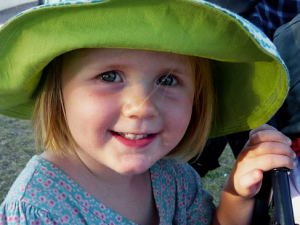 Background: The Gesell Institute of Child Development has observed that children go through a repeating sequence of six different stages with predictable changes in mood and behaviour in each. Three Years includes two such stages, each six months long. The behaviour observed in these stages reflects the qualities associated in tradition with the planets—with Venus and Mars qualities respectively. The developmental traits in these profiles represent only one aspect of children’s behaviour and may be masked, modified or intensified by other factors, both individual and environmental, such as temperament, gender related behaviours, high stress levels, over-stimulation, too much screen time or organic problems.
Background: The Gesell Institute of Child Development has observed that children go through a repeating sequence of six different stages with predictable changes in mood and behaviour in each. Three Years includes two such stages, each six months long. The behaviour observed in these stages reflects the qualities associated in tradition with the planets—with Venus and Mars qualities respectively. The developmental traits in these profiles represent only one aspect of children’s behaviour and may be masked, modified or intensified by other factors, both individual and environmental, such as temperament, gender related behaviours, high stress levels, over-stimulation, too much screen time or organic problems.
Note: If your child has turned a particular age but shows none of these behaviours, please read the previous age level, or just wait a few months, then read this again!
These profiles integrate the wonderful descriptions from the Gesell Institute of Child Development research and the ideas of Rudolf Steiner into my own research. Direct quotations from Gesell are in ‘single quote marks’ or indented.
View/download as pdf Three
Younger Threes: Three to Three and a half
A stage with Venus qualities
In Younger Threes we see qualities and motivations traditionally associated with Venus: a priority for love, good personal relationships and harmony which brings more sociability, amicableness, cheerfulness, cooperation, and compromise. They also have an increasing capacity for a sympathetic understanding of others, which encourages kindness; they can be warm, gentle and tactful. They live through their feelings, in both sympathy and antipathy. They are nurtured by beauty in all its manifestations: artistic, in nature, in sensual experiences, in human warmth and physical environment.The stage of Three years to three & a half years is described by Gesell as being ‘in equilibrium, rounded and well balanced’, a time of new ‘smoothness, integration and control.’
The emphasis in physical growth is now becoming established in the chest and rhythmic system. One sees this during this year in the gradual broadening and sometimes ‘fattening’ of the chest and in the behavioural parallels in growth in imagination in play and artistic work, social awareness and cooperation, interest in their own and others’ gender attributes and in deepening emotional life, all consistent with the Venus qualities.
By Three the destabilisation which occurred at Two and a half (with their new sense of physical separateness from mother and significant carers, their Mercurial struggles) has begun to settle. They have calmed down. Three to three and a half is a stage of consolidation where the child likes to ‘potter’ with the loved adult, to practice established skills. They need time just to be in the present, to be ‘a watcher and a waiter’. They can show more reluctance towards being pushed into new experiences and situations. It is a stage of establishment rather than adventure. In a pushy, hurried, stressed world, with time constraints and often both parents working outside the home, the children’s struggle and stresses at Three come more from an unaccommodating outside world rather than within themselves.
For Younger Threes are self-dependent and more sure of themselves. They like to make choices for themselves within their capabilities; their new sense of security can be seen in their behaviours— they are no longer dependent on rituals to protect themselves; they are less dependent on taking toys to bed with them; they are beginning to sleep through the night without wetting or having to be picked up; they may not want to hold an adult’s hand on outings except, sensibly, in crossing the road. This new confidence also comes in part from their increasing physical coordination; they can now dodge and turn, stop and go, more surely, more nimbly than before. They are more coordinated in their movement and can be helpful in doing domestic tasks. They can also mostly eat their meal without assistance, although may still want to get up from the table and they either talk or eat.
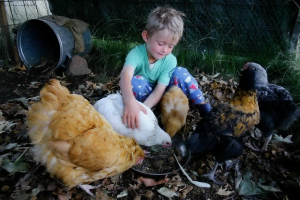
Their increasing grasp of language now makes it possible for them to express their desires verbally. “I can do it all by myself” or “I want to do so and so.” Gesell adds: ‘Three is also aware of and proud of his increasing maturity and increasing ability. He frequently asks, after some particular display of prowess, “Could a baby do this?”’
Nevertheless, their sense of personal self and other personal selves is still fragmentary and imperfect, for they still largely experience themselves as part of the whole. As their awareness of the discreteness of things increases, so they also become sensitive to incompleteness and fragments and may be concerned that things be fixed, or disturbed by ‘incompleteness’ like the man with only one arm!
This is an age where the need for independence is not as strong as the enjoyment of doing things together with others. Gesell researchers described this:
Three is a highly “we” age. The child likes to say “let’s” as “Let’s go for a walk shall we?” The sense of togetherness or “we-ness” seems to make him depend on the adult and makes him lean on him or her, though he also enjoys the sense of sharing. The very child who has been so independent earlier may now ask his mother “Help me,” “Show me.”
This new sociability, along with their cheerfulness, affectionateness, and placidness, all such strong Venus qualities, makes life with Younger Threes all the more enjoyable. Gesell notes: ‘Emotionally, it is fair to assume, the typical Three year old is a rather happy person—calm, collected, secure and capable, friendly and giving. He conforms easily, and thus, liking to please, he pleases.’
Yes, they also like to conform, to do things right and cooperate with others. This is expressed by, “Is that right?” “Do it this way?” They may ask for help especially from a carer though they may be capable of doing what they are asking to be helped with. They are more flexible in their relationships, there can be give and take now; they can be bargained with and wait their turn. New language allows more identification of and refinement of feelings and expression. They can express refusals by “I don’t want to” more often than just “no”. They express their limitations by “I can’t” or “I don’t know” or may quickly change the subject.
Younger Threes also show a Venus-like sensitivity to other people’s feelings (the beginnings of empathy?) They are ‘beginning to be interested in other children’s feelings, in how things seem to others’. Gesell researchers describe this:
Three seems, for all his relative immaturity, to be rather highly aware of what other people like and do not like. In fact many seem quite able to tell whether another person is happy or sad, pleased or angry, by watching that person’s face. At any rate the typical Three-year-old wants to please. He wants to do things “right.” “Do it dis way?” he may ask hopefully. He is highly susceptible to praise and favourable comment and also highly responsive to friendly humour.
This new amenability is evident in their play. Gesell researchers describe this:
With regard to other children, Three is the age when cooperative play now begins to take the place of parallel play—that is the child actually plays with another child instead of merely beside him, as formerly. Children may seem less selfish than just earlier, and may not only share possessions with others but can themselves … persuade another child who wants to grab his toy, that something else might be just as acceptable …[They]can use sharing and turn taking… For the most part children are now more interested in each other than any particular activity… Cooperative play still tends to be…rudimentary. ..Interpersonal relations are still tentative and experimental…[There is] less aggression but more excluding.
Dramatization and imagination are beginning to enter into their play. They show interest in combining play things such as blocks and cars, making roads, bridges and garages. As they play more with other children rather than separately, their groupings are small but fluid in makeup and activity. Cooperative activity thankfully is taking the place of physical contacts.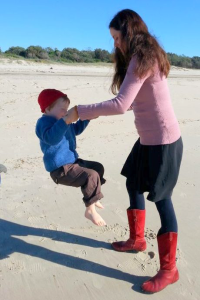
One of the biggest challenges reported by mothers of Young Threes lies in the children wanting so desperately to be doing things with them all the time; especially single and first children may want this. Gesell describes the origin of this:
…Three now enjoys other children, but most of all he enjoys his mother. He loves to do things with her—go for a walk, go to the store, “help” with the housework, and, above all, play. He is happiest when his mother finds it possible to give up other activities and concentrate on him. Almost anything the two of you do together brings him joy….
Luckily by this age the child is able to wait and to do simple domestic tasks with an adult and they want to do things right. This is an ideal time to go back to domestic basics some of the time, with home baking, gardening, with leaf rake (rather than leaf blower), simple cleaning by hand and broom (instead of vacuum cleaner), washing small things by hand, activities the children can be part of, beside you. Here you need the skill to divide up the tasks where the child can be helpful with simple tasks but you can still make progress in your tasks! Here is the opportunity to teach them safety (for example about the sharpness of knives and the hotness of the stove) while also learning skills and gaining confidence. You can also make work more playful, with imaginative story telling with food preparation (making a garden with food on the plate for example) or singing made up rhythmic songs with the tasks. Meeting children’s needs in such ways can remind us to slow down and make everyday living joyful again too. This is creative, more fulfilling parenting and living with children.
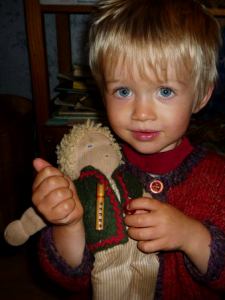 It should also be remembered that the child can also find company in his or her “companion doll”, the favourite doll “ensouled” by the child. The therapeutic value of dolls for both boys and girls should not be underestimated. Boys and girls need loveable dolls to love and care for, dolls they identify with as human beings, to be tender with, even to be cross with, to be themselves with. The stages in early childhood where love and relationships are a priority (Younger Twos-Moon and Younger Threes- Venus) are ideal times to make sure children have an appropriate doll to love and care for. The doll needs to be one that you intuitively want to pick up and cuddle, one with softness, roundness, a well-proportioned child’s face, one that draws tenderness out of you (make sure the eyes are not too close together).
It should also be remembered that the child can also find company in his or her “companion doll”, the favourite doll “ensouled” by the child. The therapeutic value of dolls for both boys and girls should not be underestimated. Boys and girls need loveable dolls to love and care for, dolls they identify with as human beings, to be tender with, even to be cross with, to be themselves with. The stages in early childhood where love and relationships are a priority (Younger Twos-Moon and Younger Threes- Venus) are ideal times to make sure children have an appropriate doll to love and care for. The doll needs to be one that you intuitively want to pick up and cuddle, one with softness, roundness, a well-proportioned child’s face, one that draws tenderness out of you (make sure the eyes are not too close together).
Given a good doll, the Younger Three can be encouraged by the adult to keep it company. The adult’s role then is to add imaginative talk to keep the child playing, and for the adult to stay present sufficiently that the child does not feel ignored (as they do when mother talks on the phone, for example— the quickest way to make any child demanding). So we can help to enrich the play when necessary, “Is dolly hungry now?” “Does he need rocking to sleep?” “Does dolly want to help you move the blocks?”
So Younger Threes is an amenable, enjoyable age for children and adults when the environment is supportive of their needs. See more in the “What helps with living with Younger and Older Threes” section at the end of this article.
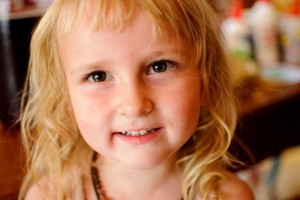
Older Threes: Three & a half to Four Years
A stage with Mars qualities
In Older Threes we see qualities and motivations traditionally associated with Mars: a priority for power and action; a stronger sense of individuality and a strong will and need for self-empowerment; a doer, with suddenness and vigour in action; an earnest, intense drive which is also used inwardly in digesting experiences.
The Gesell research descriptions of the child at this age are mostly quoted from Louise Bates Ames and Frances L. Ilg’s book Your Three Year Old. Friend or Enemy
While much of the general advice given for Younger Threes also holds for Older Threes, there are also new challenges to our understanding for the children of this age. The picture of Older Threes which the Gesell researchers give is at times not a very positive one. They describe them as being ‘in disequilibrium and inwardized’. The good motor coordination seen in Younger Three gives way to an ‘uncoordinated insecurity’ in both large and small movements; they have more difficulty with their spatial orientation; they stumble and fall and are ‘uncertain, tremulous, even helpless’. One see this in their speech, with stuttering, in their drawing in ‘thin wavery lines’, in visual difficulties (in complaints that they can’t see, in twitching and blinking) and in increased tensional outlets like ‘ stuttering…nail biting, thumb sucking, nose picking, rubbing of genitals, chewing on clothes, excessive salivation, spitting, tics and whining.’ Gesell sees whining as particularly characteristic of Older Threes.
Their emotional insecurities, which may be based on these temporary motor difficulties, create troubles, stresses and strains. They have ‘great difficulty in managing [their] turbulent emotions’. ‘They show extremes of shyness and over-boldness.’ The children are also more ‘anxious’, more ‘uncertain’ and more ‘insecure’. They show greater self-consciousness (‘Don’t look!”)’
We do in fact also see positive aspects at this age. Gesell points out: ‘in spite of all this frequent ineptness and motor inadequacy, the Three-year-old much of the time shows himself increasingly skilled and effective in motor ways.’ They can jump rather high and far, run smoothly with pleasure, balance, hop, play ball and ride a tricycle.’
Bates Ames and Ilg also describe Older Threes’ more endearing qualities:
During the smoother parts of the day—between routines—he may be loving and amusing, his most delightful self. Warm, friendly, appealing, affectionate and confiding, creative and delightful he can be at such times… he can show imagination, inventiveness and a real capacity for play. He can be aware of the other person’s feelings and can be extremely endearing as he expresses his own affections.
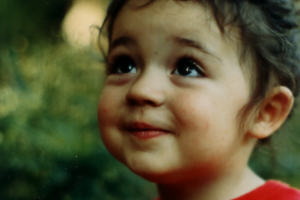
This is consistent with the emphasis in physical growth now being well established in the chest and rhythmic system which brings natural interest in all things to do with the heart and feelings –social interests, imagination and creativity, which have all begun to blossom at Three and continue on at Three-and-a-half. Interest in their own and others’ gender attributes also continues.
Amongst the challenges we see in Older Threes we can identify some aspects of Mars’ qualities which may help in our understanding of them. Firstly Mars is associated with an earnest, direct, intense drive which can be seen in outward thrusting qualities as well as inward digesting qualities. Older Threes experience a spurt in new physical development, and show a vigour and thrust in their movement which verges on being aggressive.
The children also experience a spurt in verbal growth. Their words, length of sentences and grammatical understanding are all increasing at a significant rate and they love to play with language and use it to express their needs. In play, their ‘verbal imagining combines with real action’. More talk is directed at others and of course in questions. Progress in speech has been considerable for the whole of Three and Gesell notes ‘never again may words mean so much as in the Three-year-old period’ and they advise ‘talk to him’! The formation of speech is also associated with the force of Mars.
The direct intense drive of Mars shows in other ways too. The relative gentleness of Younger Threes is being replaced by a different energy, that of a strong will, with vigorous directed movement and action, which perhaps the children do not yet have under their control. The Gesell researchers describe this:
… the Three-and-a-half year old, for all his anxiety and difficulty, is much more an actor and a doer. There is a suddenness and vigour about his behaviour that is rather striking, though not always comfortable. He may suddenly wet his pants, surprising even himself; or he may suddenly burst out crying when things do not go his way.
One also sees the vigorous and still somewhat uncontrolled will in Older Threes’ sense of humour, which they share even more with other children than adults now. Their movement and energy verges on aggressiveness, when the children get caught up in the action rather than considering, as they might have done just earlier, their effect on others. The Gesell researchers describe: ‘wild, silly, gross motor activity. A child may laugh and run wildly, may jump wildly, throw things around wildly, crash a truck down an incline.’ This behaviour inevitably tends towards ‘aggressivity’. ‘A child knocks down another’s house, pushes another child down, kicks another child’s train.’
Their need for control and power reveals itself in aspects of their play, for example, in their interest in bossiness. Gesell notes: ‘This is the age above all others when many children enjoy the company of imaginary people or animals,’ ‘or pretend that they are someone other than themselves.’ ’Some companions are weak and easily bossed around by the child. Others are bossy and extremely demanding.’ This interest in bossiness can be used creatively in getting them to do what really needs to be done, in being “boss of themselves”.
With such potentially negative behaviours in Older Threes, perhaps it is good to be reminded that this driving force which they experience seminally at this age in their will and individuality, can mature into the gift of action and noble service to others which we find in a mature Mars type: for they can be enthusiastic, passionate, positive people, who actively take the initiative and assert their strong will to act and get things moving, to lead, organise, serve and protect others.
A second aspect associated with Mars which may help in understanding Older Threes is that they are more strongly individualised and seek personal empowerment through a strong will (ultimately to serve, lead, direct). Older Threes are more individual and show a clear tendency to want to be in control and to resist control by others; they are also characterised as having strength of will and independence; they are not as amenable as younger Threes, and their need to be treated more as an individual may be another key to understanding them. Gesell describes this: ‘He is developing a deepening sense of himself in relation to, but also as apart from, others and thus is not as interested in the concept of “we” as he was just earlier.’ Here again we see the slight step back from people that we sometimes see in a Mars type and a stronger individuation, and more interest in doing the task at hand than working with relationships.
Along with this new awareness of themselves as individuals, there also comes a greater self-consciousness in the presence of others which seems to add to their confusion. One minute they want the attention, then the next minute it is too much for them to deal with and they don’t want it. Gesell describes this in Older Threes:
“Don’t look,” ‘Don’t laugh”, “Don’t talk,” he commands those around him. But in his immaturity, he is often inconsistent. “Don’t look” he may order one minute, and at the next may become very angry if not given full attention. He may then insist that all attention be focused on himself and may feel left out if it is not. He may refuse to let Father read his paper, or Mother chat on the phone, or let two adults talk to each other.’…‘He seems to feel invaded even by people’s glances.’
It seems they at times have difficulty in digesting the sensory input of people’s attention so that it can become overwhelming for them. Their bossy demands may be a desperate way of defending themselves and dealing with the inner conflict of wanting, and then not wanting, attention, and the insecurities that brings.
Gesell says: ‘One might assume that [their] strong willed self-assertiveness, which is so conspicuously evident, might be rooted in a strong personal security. Not so! In fact the very opposite seems to be the case’ for they are also characteristically ‘inwardized, insecure’ and ‘anxious’. ‘The Three-and-a-half year old child seems emotionally insecure from the word go.’
The inwardized nature of Older Three may also be a reflection of another side of Mars, where the active forces turn inward into the digestion of experiences, which we see even more strongly at Seven and Thirteen, the following Mars stages.
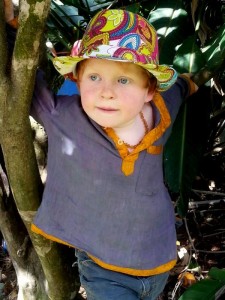
Older Threes’ strong will, their need for control, their self-assertiveness and their independent spirit all create problems for themselves and others. Gesell describes this:
Refusing to obey is perhaps the key aspect of this turbulent, troubled period… It sometimes seems to his mother that his main concern is to strengthen his will, and he strengthens this will by going against whatever is demanded of him by that still most important person in his life, his mother. Many a mother discovers that even the simplest event or occasion can elicit total rebellion. Dressing, eating, going to the bathroom, getting up, going to bed— whatever the routine it can be the scene and setting for an all-out, no-holds-barred fight.
They continue: ‘Routines seem to give him the most trouble. Mealtime and dressing may be two of the most difficult routines. Each bite, each garment, may provoke a full-fledged battle.’ ‘Sometimes it almost seems that nothing pleases.’ He is telling us what he wants and needs in that he ‘attempts to control his environment in ways that will, perhaps make him feel more secure, more sure of himself.’
A third aspect in relation to Mars is that when strong will and intention is blocked, it creates significant problems. Older Threes show emotional insecurities and behaviours which may be the result of the will, or driving force associated with Mars, being blocked or interfered with in some way. Imagine a fast moving spear hitting a shield with a thud. When Older Threes’ inward or outward physical movement comes to an unexpected stop we see some characteristic blocked behaviours. Gesell describes Older Three: ‘He stutters. He stumbles. He trembles. A child who six months earlier may have walked a proud one-foot-to-a-step up the stairs may now go back to a more babyish two-feet-to-a-step.’ ‘Handedness may shift at this age, and it may seem as if the child actually does not know which hand to use.’ They also have more fears of heights and falling.
Stressful times in people’s lives do tend to bring regression in behaviours, and we certainly see this in childhood at the more stressful stages. Growth of course is also not simply linear. In Older Threes it sometimes seems that life is just too driven, the forward movement is just too fast. Gesell also suggests that perhaps the children this age just try too hard. Could it be that they cannot quite manage the extra ‘propulsion’ which the determined will gives them at this age and they overdo it, go too fast, trip themselves up in some way? Or could it be that their movement and will are being blocked in some other way. Emotionally one can see the children seem to be driven by the force of their will, wanting to use it to be in control of the situation. However sometimes they find they cannot do as they want, because the will of others intervenes, especially the will of their major carers, who care enough to insist that some things need to be done. Then the children’s will may be blocked, frozen, stymied. Could what we are seeing be “blocked will” appearing in the physical body?: stuttering—blocked speech; stumbling and trembling, regression in skills like walking, handedness shift and confusion—blocked movement, intention and will? Is the experience of all this the source of their anxiety and insecurity?
One sees this in other ways too, in the behaviour Gesell describes:
Inconsistency is also expressed in the emotional extremes of this interesting age. The child may seem to be extremely shy at one minute and overbold the next. Inconsistent, and determined to control the adult, he can make things difficult since he must—but definitely must—have his own way about everything. He is surprisingly firm in enforcing his own demands. If, while out for a walk, he decides that he will not go any farther, he will stand stock still. If you walk away, assuming your departure will motivate him to follow, you can continue on until he is but a speck in the distance. He will not budge.’
Could this also be more than just stubbornness, or just wanting his own way (though that is certainly part of it)—could it perhaps also be more of an inner conflict in his will that freezes his movement and intention—like a blocked Mars? Also when, in Gesell’s words again ‘he will set up a “nothing-pleases-me” situation in which, as when taken shopping, he does not want to go into the store, but at the same time refuses to stay in the car, and will howl bloody murder whichever alternative you choose.’ Is this in some way also “frozen will”? Can we find help for poor Older Threes by asking ourselves what frees the will? Of course, if it is possible, it may be better to avoid the conflict altogether. It may be that for a time that Older Threes are better off being at home, and excursions are best left for a time soon when the child will manage better.
Older Threes need to have control but they don’t respond to old ways of working with them. How then does the parent work with this? What can gently disengage the will, or slow down the strong impulse and bring it again under control. How can we offer self-empowerment of a different kind?
For a start, this Mars-like assertiveness and strong will and the need for independence in Older Threes needs honour and respect. They will need these qualities to develop resilience and the strength to do what they think is right in the world, to be warriors for the good. But we need to find ways to avoid battles, for full on “face to face” confrontation obviously does not work at this stage. We also as adults need to recognise when the children’s power unconsciously threatens us and activates a primitive power reaction in us too. We need self-restraint and a mature conscious response not reaction. Any power battle here is self-defeating. There are no winners. Pushing only strengthens resistance. We need to find ways to give ourselves time for appropriate responses and to give them a space which allows them to step forward, allowing them to use the individual initiative and power they crave.
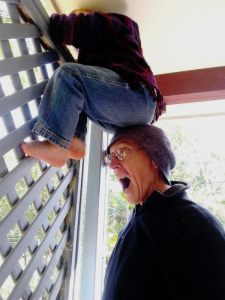
It is important with children in such a wilful stage that we try to find ways to bring our intentions into line with theirs. How can we creatively redirect their potent energy in the direction we/they need it to go for healthy development without sabotaging their independence? Imagination can be a wonderful help here. The use of imagination and creativity can bring the child (and ourselves) into a different space—it can help to disengage head thinking and conflict of wills, by bringing ourselves into our hearts. We can lead the child into the next activity we need them to do, by taking them in imagination to a new place, or along a different path, being the farmer, or the garbage man. Dollies get tired and need to sleep, or get hungry and need to eat; trucks need to be cleaned up and put in the garage out of the rain. Imaginary friends may be helpful here too. Simple stories and little rhythmic poems like nursery rhymes do this, along with a little bit of nonsense and play with words. Singing and songs also take the child into a heart space which can disengage the head and will.
I do not like to describe what we are doing here as using “distraction” because this imaginative play needs to come from our hearts not our heads. As we saw, ‘Three-and-a-half is amazingly sensitive to the reactions of others’, and they will be sensitive to adult tricks too. If they are true to the Mars type, they also appreciate open, direct and honest communication and do not like deviousness or trickery. So what the parent does, needs to be done honestly with a full heartedness and a belief in the child and in ourselves. The children recognise when you are genuine in your interest in them, in your recognition and enjoyment of them and what you are doing together, even in getting those two shoes on their feet in the morning. We need to find ways that will encourage them to come along with us through respect for them. Once again they can help us to grow with them, to become more imaginative, to let go and sing, to say silly rhymes, to be more playful. Life is so much richer when we can do these things.
That said, all this is not so easy, for, as with a Mars type adult, and with boys in general (Mars also represents the male principle), one needs to be very strong and clear with boundaries with a Mars stage child. But clearly bossy authority is not going to work very well with Older Threes. We need to work with the Mars energy in other ways. For example, indirectly, to get the authority with its rules and guidelines well “embedded” in the environment, in the set routines and order and predictability of everyday life. We need to make the way things are done into a “fact of life”, taken for granted realities, “This is the way it is done here”, this is “tribal law” (not an individual preference), in order to avoid personal battles and resistances to instructions. However, direct or indirect provision of boundaries, rules and guidelines needs to be done with an equally determined adult inner will and authority. Mushiness will not do for Mars. One needs to be equal to their will and determination to get their respect. Gesell researchers actually describe this need for inner strength in dealing with Older Threes, when they say: ‘The Three-and-a-half-year-old fights only with a worthy opponent—his mother’ [or major carer.]
Given that the greatest problems with Older Threes is with routines, with the everyday tasks of life that need to be done, dressing, eating etc. it is wise to keep these routines and the details of the routines as rhythmical and the same as possible so that, with luck, you will not have to fight for each thing to be done, but just have to start the order going. Order and predictability help children to feel safe. Here too, when one can bring creativity and beauty into the necessary routines of everyday life, life is enriched and made more enjoyable. When food is home cooked with love, when it is served on a table with a flower and a candle, with all the family there to share with, it becomes more than just a meal. When bed times involve special times for stories, for sharing, for a lavender foot massage, for being sung to sleep, why should the children resist them? Being unhurried and being given warnings, being part of preparations, and being given time, all help children to make transitions from play to the routines of everyday living which Older Threes have the propensity to resist. At an insecure stage like this one, consideration of all these things are even more important. It is not easy to do this in our hurried world but the rewards are great for us all.
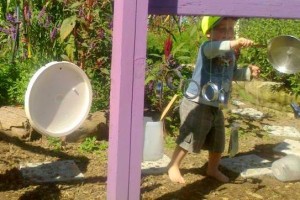 At this age, the major care giver gets the worst of the difficult behaviours in Older Threes. To get a break from the intensity of the strong willfulness at this age Gesell suggests parents get the help of a good babysitter or that they get some respite with the child in kindergarten /nursery school three mornings a week, for the children often behave better with others. Gesell explains this: ‘But the fact seems to be that Three-and-a-half is amazingly sensitive to the reactions of others. He knows that the sitter really doesn’t care whether he eats or goes hungry, gets rest or becomes exhausted. With exquisite sensitiveness he deals out the grief to the person who does care, his mother… ‘
At this age, the major care giver gets the worst of the difficult behaviours in Older Threes. To get a break from the intensity of the strong willfulness at this age Gesell suggests parents get the help of a good babysitter or that they get some respite with the child in kindergarten /nursery school three mornings a week, for the children often behave better with others. Gesell explains this: ‘But the fact seems to be that Three-and-a-half is amazingly sensitive to the reactions of others. He knows that the sitter really doesn’t care whether he eats or goes hungry, gets rest or becomes exhausted. With exquisite sensitiveness he deals out the grief to the person who does care, his mother… ‘
Gesell also advises parents to work on building good relationships at this age. At all ages this helps children, but it meets a special need in terms of a Mars stage, for what they need is recognition as an individual, treatment as an individual. They need, not just cuddles, but genuine interest in and affirmation of them, honest enjoyment playing with them, talking with them, earnest listening to them. The communication and recognition has to be real. Let this time too be a time for you to slow down and be present, be mindful. This is a gift to ourselves as well. When this happens there is more chance of cooperation, for the “happy helpful child” to shine through. Note that this time spent with children should not be a full time occupation. The children can still wait, do things on their own but it is important that at least some of the times of interaction with them are taken seriously and made special. Bed times are good for this. Once the relationship is good, the children’s needs become less intense. This is definitely a time when “fobbing children off”, ignoring, not hearing, brushing them off in the busyness and stressfulness of life are going to be counter-productive. Investment of time and care will bring healing to an anxious age. When you are really there with them, they feel more safe even with their fears and insecurities. These need recognition and reassurance too.
Older Three is followed by a stage with even more powerful energy. At Four, Jupiter qualities bring an even more energetic, egotistical and expansive time.
What else helps in living with Younger and Older Threes?
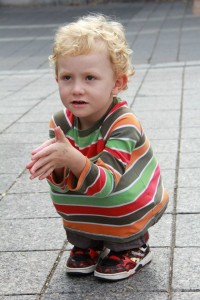
There is a lot of literature on the early childhood years with just two, a Gesell book and Simplicity Parenting suggested in Further Reading below. Briefly however, here are some things which are helpful in preventing misbehaviour in Threes (and all young children): good routines, predictability, protection from over stimulation and stress, warnings and help to make transitions, diversion, business-like instruction (which does not invite resistance), realistic feedback and approval, repeated explanations and genuine praise, unobtrusive help through problems, negative messages to be given in a positive form.
Routines and special predictable ways of doing things build a sense of safety in the young child’s life and avoid the potential for fighting over every little daily task. They are needed even more strongly in stressful times, when we are are often most tempted to drop them. When routines are also carried out with love, creativity and beauty, they can become enriching for adults and children alike. Even such simple things as having a candle and a special song at every bedtime can slow us down and prepare the child for sleep in a calm helpful way.
Threes also need time, much more than our world is likely to provide for them today. They need us to slow down. They need help to make transitions by preparing them first, telling them what is coming next, and entering into their play with imagination to lead them to the next step: “Time for the farmer to have his lunch, so where will he park his tractor?” or to use a song, or funny poem, creating enjoyment in the ordinary. Children need time for digestion of experiences, times of quiet and dreaming, without interaction; they need time to breathe, both in and out. Children take everything in, the movement, the noise, the visual stimulation, the touch, the smells, the calm or stress, the love or anger. We need to make sure what they are taking in is truly nourishing.
Threes cannot necessarily separate the real from the unreal/ fantasy. This can include strong emotions portrayed in story telling or in “scary” play with older children, for example playing monsters, or even a parent taking another role, like playing at being an elephant. Even Santa Claus in real life can be very scary to Threes. These experiences can aggravate nightmares and insecurities at Three, so are best avoided. However if the child does develop fears positive action to relieve the fear is more likely to help than just reassurance. So the Three year old who feared that a lion would come into her house was calmed by a sign on the front door which said “No lions allowed in here!”
At this age language is developing rapidly and with this comes their questions. Threes are not very good yet at being able to formulate a question precisely, so their questions can go on and on, as they try to get to what they want to know from you. In trying to understand what the child is really seeking it helps to know their primary interest is in the purpose of things (i.e. function) rather than in how they work. What they want to know may be surprisingly simple, like a name. “What’s that?” “That is a caterpillar.”
So Younger Threes, the Venus age, is a time for loving relationship and compassion, for caring, for beauty, imagination and for creative and sense-nourishing experiences; it can become the children’s gift to us, to join them in a warm, unhurried, loving Venus place. Older Threes, in a Mars stage, present us with new challenges which are more about power— about gathering our own inner authority and clarity, and about supporting our children in their learning about healthy self-empowerment.
View/download as pdf Three
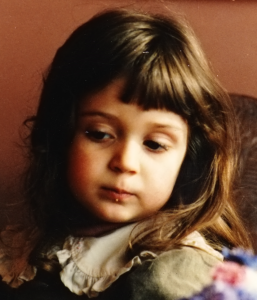
Further reading
Your Three Year Old Friend or Enemy (Dell Trade Paperback, New York 1985) by Gesell researchers Louise Bates Ames and Frances L. Ilg A Gesell Institute of Child Development book.
Payne, Kim John, with Lisa M. Ross Simplicity Parenting Using the Extraordinary Power of Less to Raise Calmer, Happier and More Secure kids. (Ballantine Books Trade Paperbacks, New York, 2009) Or their website: www.simplicityparenting.com
See also
Avoiding trouble with young children
Healthy play
Strategies for healthy living with young children
Family celebrations
Brief descriptions of the planetary qualities